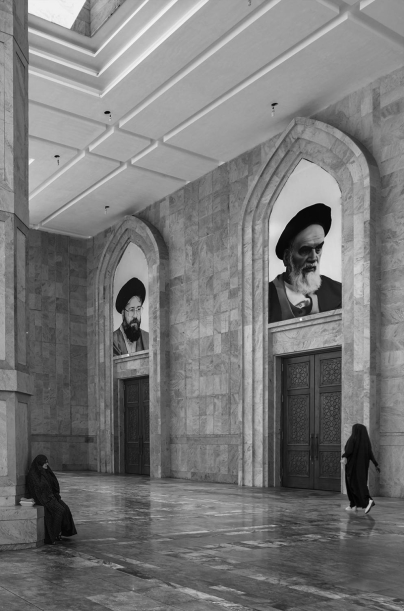

[ Entrance porches to Imam Khomeini Mausoleum south of Tehran. 2017 ]
Everything around Khomeini's mausoleum is enormous, pharaonic. The grandeur of the spaces, including the portraits of the leaders, contrasts with the smallness of the people in relation to them. All of this, and not by chance, is a perfect simile of today's Iran.
I was trying to portray the woman on the left who remained absorbed in her prayers and meditations. I was about to take a short shot, but I pulled the viewfinder of the machine back and the portrait of Khomeini appeared immense. I stepped back a few meters and knew that this was the picture I was looking for.
PERSIAN DIARIES I. A Persian-style theocracy and religious fervour: (Living) Under Chador
Photographer: Rpnunyez .
Exhibit Title: PERSIAN DIARIES I. A Persian-style theocracy and religious fervour: (Living) Under Chador
Location: Iran
Iran, a paradigm of modern theocracy, lives under the long shadow of the man who in 1979 returned from exile in Paris to end years of waste, corruption and terror of the Pahlevi dynasty by establishing the Islamic Republic of Iran.
When, on February 1, 1979, the Iranian people welcomed Khomeini's return with genuine jubilation, they did nothing but express their hope for a more dignified life and, perhaps, for the recovery of a lost identity.
It is, however, paradoxical that the children of those who kissed the shoes of Rheza Pahlevi, the last Shah of Persia, or of those who tore down one after another the hundreds of effigies of him spread all over the country, must today live under the thousands of portraits of Ruhollah Mousavi Khomeini or his successor in office that flood today's Iran.
An Iran in which the chador, an element of oppression for some and liberating for others, is omnipresent and represents by itself the enormous complexity and contradictions of the present Iranian regime.
rpnunyez@gmail.com
https://www.rpnunyez.com/
Make Comment/View Comments